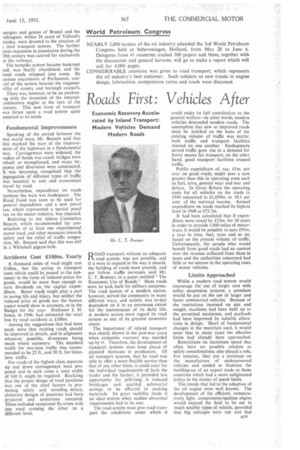Roads First: Vehicles After R OAD transport , without an adequate road
Page 53

Page 54

If you've noticed an error in this article please click here to report it so we can fix it.
system, was not possible, and if it were to expand in the way it should. the building of roads must precede, and not follow, traffic increases, said Mr. C. T. Brunner. in a paper entitled "The Economic Use of Roads." Most roads were, he said, built for military purposes. The road system of a modern nation, however, served the community in many different ways, and society was to-day dependent on it to an enormous extent for the maintenance of its daily life. A modern nation must regard its road system as one of its greatest economic assets.
The importance of inland transport was clearly shown in the post-war years when economic recovery was speeded up by it. Therefore, the development of transport systems must keep ahead of planned increases in production. Of all transport systems, that by road was able to offer a more flexible service than that of any other form; it could cater for the individual requirements of both the trader and the farmer; it provided less opportunity for pilfering; it reduced breakages and enabled substantial savings to be effected in packing materials. Its great mobility made it an ideal system when sudden abnormal requirements had to be met.
The road system must give road transport the conditions under which it could make its full contribution to the general welfare—in other words, modern vehicles demanded modern roads. The assumption that new or improved roads must be justified on the basis of the existing volume of traffic was sterile: both traffic and transport facilities reacted on one another. Inadequately served traffic gave rise to a demand for better means for transport, on the other hand, good transport facilities mated traffic.
Public expenditure of, say, Elm. per year on good roads, might save a sum greater than this in operating costs such as fuel, tyres, general wear and tear and delays. In Great Britain the operating costs for all vehicles on the roads in 1949 amounted to £1,039m. or 10.1 per cent. of the national income. Annual expenditure on roads reached its highest level in 1948 at £73.7m.
It had been calculated that if expenditure were raised by £55m. for 10 years in order to provide 1,000 miles of motorways, it would be possible to save £95m. a year in time, fuel, tyres and so on. based on the present volume of traffic. Unfortunately, the people who would benefit from good roads had no control over the revenue collected from them in taxes and the authorities concerned had little or no interest in the operating costs of motor vehicles.
Limits Approached
Whilst a modern road system would encourage the use of larger cars with softer suspension systems, a premium would be put on the use of larger and faster commercial vehicles. Because of the restrictions imposed on size and weight, machines had been built up to the permitted maximum, and payloads had been improved by suitable alterations in design. Short of fundamental changes in the materials used, it would seem that in many cases the effective limits had already been approached.
Restrictions on maximum speed that often bore no possible relation to safety considerations, also played a role. For instance, they put a premium on the manufacture of underpowered vehicles and tended to frustrate the building-up of an export trade to those countries which had a more enlightened policy in the matter of speed limits.
The trends that led to the adoption of the oil engine were well known. The development of the efficient, comparatively light, compression-ignition engine, would expand the field to its use in much smaller types of vehicle, provided that big mileages were run and that
economy and a fair average speed were regarded as of greater importance than high acceleration and high maximum speeds.
It would be wrong, said the author, to ignore the potentialities of the gas turbine in the foreseeable future, although its development was in only its early stages. The significance of a small, yet powerful, unit could probably be best appreciated in the field of commercial road transport as the increase of the payload factor might permit of substantial savings being
made in costs per-ton-mile provided that its present high rate of fuel consumption could be reduced to compete with the oil engine
Mr. Brunner said that a large vehicle was more economical than a small one, assuming that full advantage could be taken of it by employing it to its capacity, and for that good roads were essential.
It might be taken as axiomatic that every change in road conditions had profound repercussions on the petroleum industry.




























































































